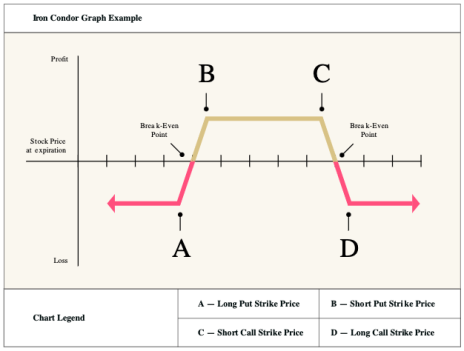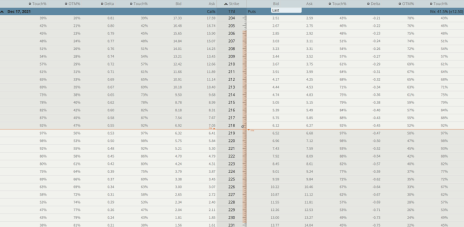Today I want to talk about the perfect set-up for an iron condor. But with a bit of a twist.
There is no doubt that volatility has increased across the board. And as volatility increases, trading opportunities increase which opens up the options playbook significantly.
Iron condors using highly liquid ETFs are one of my favorite defined risk, non-directional options strategies in a high implied volatility environment. As for the name “iron condor,” well, the name makes perfect sense when you look at the profit/loss chart below.
[text_ad use_post='261460']
The strategy consists of a short call vertical spread (bear call spread) and short put vertical spread (bull put spread).
But today, due to the short-term oversold reading in the Russell 2000 (IWM), I’m only going to put on a bull put spread, with the intent of adding the bear call if IWM happens to push higher over the next few days. If it doesn’t, so be it. I’ll still have an opportunity to make a decent profit in 17 days or less. Best of all, due to the inflated premium in the market right now, I can go with a trade that offers an 85%+ probability of success.
Step One – Liquidity
Liquidity is king. The first step when trading iron condors, or any options strategy for that matter, is to make sure you are choosing a highly liquid stock or ETF. Some of the best ways to find out if an underlying security is liquid is to take a look at the open interest, volume and bid-ask spread for the at-the-money options.
I have created a list of highly liquid stocks and ETFs that I like to trade and I rarely stray from that list. Why would I want to trade an underlying security that requires me to make back 5% to 15% on average just to get back to breakeven? It doesn’t make sense. Remember, we want to use efficient products that allow us to get in and out of the trade with ease. Don’t overlook the importance of using highly liquid securities.
Step Two – Expected Move
Let’s say we decide to place a trade in the highly liquid Russell 2000 (IWM) going out roughly 17 days until expiration.
As you can see below, the expected move, also known as the expected range, is from roughly 206 to 231.
In most cases, my goal is to place the short strikes of my iron condor outside of the expected move. Moreover, I prefer to have my probability OTM or probability of success around 75%, if not higher, on both the call and put side.
Step Three – Choosing Expiration Cycle and Strike Prices
Since I know the expected range, as seen above, for the Russell 2000 (IWM) for the December 17, 2021 expiration cycle is from 206 to 231, I can then begin the process of choosing my strike prices.
Remember, IWM is currently in a short-term oversold state so I’m going to focus on selling a bull put spread and wait to see how IWM reacts before potentially selling the other side of the iron condor, or bear call spread. I will continue to write about the trade and my intent going forward so you can follow along if you wish.
Put Side of the Iron Condor:
The low side of the range is, again, 206 for the December 17, 2021 expiration cycle, so I want to sell my short put strike just below the 206 strike, possibly lower.
As you can see above, the 195 strike with an 85.71% probability of success fits the bill. In fact, it is a very conservative approach to the trade. But I’m OK making 8% to 12% over the next 17 days or less on a trade that has an 85.71% probability of success.
Now, once I’ve chosen my short put strike, in this case the 195 put strike, I then begin the process of choosing my long put strike. Remember, buying the long put strike defines my risk on the downside. For this example, I am going with a 5-strike-wide iron condor, so I’m going to buy the 190 strike.
Again, it’s all about the probabilities when using options selling strategies. The higher the probability of success, the less premium you should expect to bring in. But as long as I can bring in a reasonable amount of premium, I always side with the higher probability of success, as opposed to taking on more risk for a greater return.
So, with IWM trading for 218.17, the underlying ETF can move lower 10.6% over the next 17 days before the trade is in jeopardy of taking a loss.
Here is the theoretical trade:
Simultaneously…
- Sell to open IWM December 17, 2021 195 puts
- Buy to open IWM December 17, 2021 190 puts
We can sell the bull put spread portion of our potential iron condor for roughly $0.37. This means our max potential on the bull put spread profit sits at approximately 8.0%. And if all goes well and we are able to sell the bear call portion of our iron condor we can kick up the max return to possibly 14% to 16%, if not higher.
Again, I want to choose an iron condor that is outside of the expected move and has a high probability of success. If IWM bounces off its short-term oversold state I would look to sell a bear call spread outside the upper range of the expected move.
Remember, when approaching the market from a purely quantitative approach, it’s all about the probabilities. The higher the probability of success on the trade, the less premium I’m able to bring in, but again, the tradeoff is a higher win rate. And when I couple a consistent and disciplined high probability approach on each and every trade I place, I allow the law of large numbers to take over. Ultimately, that is the true path to long-term success. I’m not trying to hit home runs. I understand the true, consistent opportunities, particularly when seeking income, come with using high probability options strategies coupled with a disciplined approach to risk management—the latter being the most important.
Step Four – Managing the Trade
I typically close out my trade for a profit when I can lock in 50% to 75% of the original premium sold. So, if I sold a bull put for $0.37, I would look to buy it back when the spread reaches roughly $0.15 to $0.10. However, since we are so close to expiration, I might ride the trade out until it expires worthless, thereby reaping a full profit. As always, the market will dictate my actions.
If the underlying moves against my position I typically adjust the untested side. Most roll the tested side, but all research states that rolling the untested side higher/lower allows me to bring in more premium and thereby decreasing my overall risk on the trade. Moreover, I look to get out of the trade when it reaches 1 to 2 times my original premium. So, in our case, when the iron condor hits $0.74 to $1.11.
Of course, the aforementioned numbers will change drastically if I’m able to sell a bear call spread over the next several days. Stay tuned!
Ultimately, position size is the best way to truly manage a trade. We know prior to placing a trade what we stand to make and lose on the trade, therefore we can adjust our position size to fit our own personal guidelines. Iron condors are risk-defined, so it’s important to take advantage of their risk-defined nature by staying consistent with your position size for each and every trade you place. Remember, it’s all about the law of large numbers.



